Urban Crossings: Planning, Mobility and Accessibility
The development of urban spots along road sections is known as Urban Crossings. In urban crossings, there is an interaction between two distinct elements: the urban structure and the highway. There is a need to reconcile these two elements, way to provide quality of life, without harming the operation of highways. That's compatibility is done through urban planning and the project adaptation of the highway in the urban crossings.
The case study comprises the cross-highway BR-116 and BR-262, in the city of Manhuaçu/MG, covering three stretches of urban crossings located in the districts of Vilanova, Realeza and Santo Amaro de Minas. In addition to the existing urban fabric, are emerging new increases, owing to new developments in the region.
The factors of local development and the consequent population growth, tends to urban sprawl along the highway, in addition to multiplying the demand for public services and modal conflicts (motorized lightweight x motorized heavy x pedestrian x cyclist). As the districts are small, with limitations in basic services, it is necessary to displace their to the municipal headquarters, generating local traffic that hinders the mobility of the highway. In counterpart to the highway, tangential to these urban areas, as a physical barrier, consists of a risk to the population and a limiting factor for accessibility. Thus, it is necessary to predict urban planning measures that seek to harmonize local demands and the vocation of the highways.
Location: Manhuaçu, Minas Gerais, Brazil
Date: June 2016











